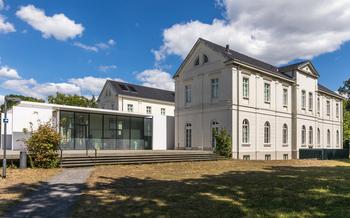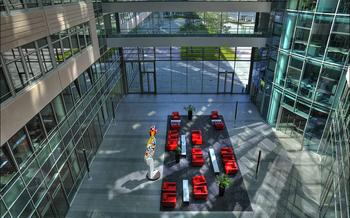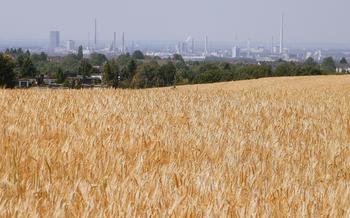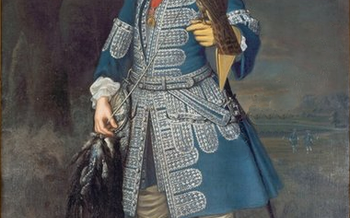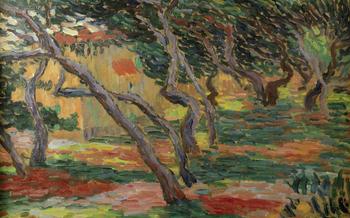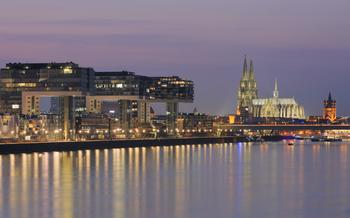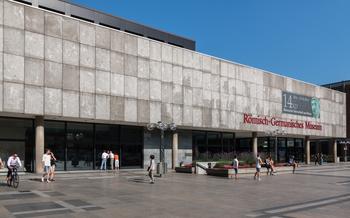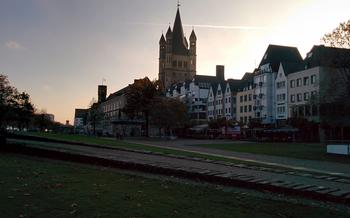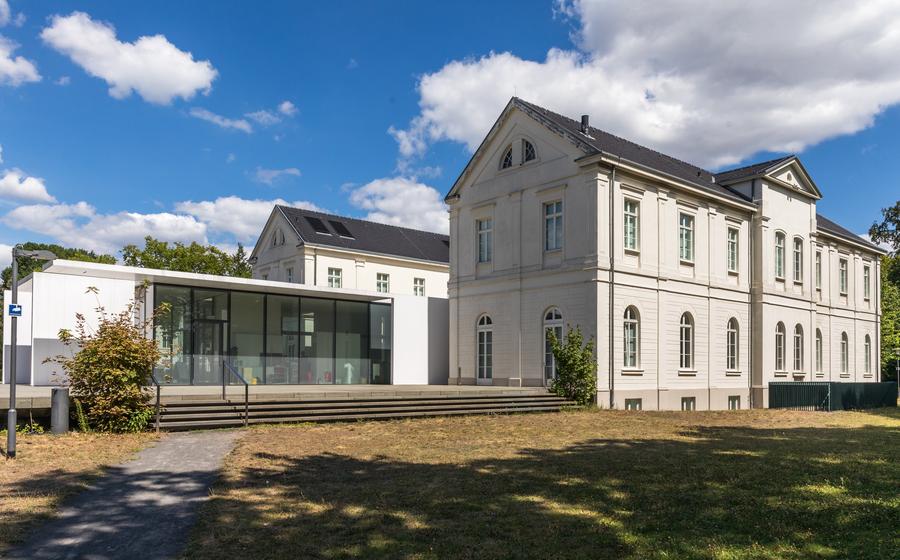
Max Ernst Museum, Brühl
- The Enchanted Forest: A Realm of Sculptures and Nature
- Max Ernst's Surrealist Masterpieces: A Glimpse into His Creative World
- Unraveling the Mysteries of Surrealism: Interactive Experiences
- Navigating the Museum's Collection: Thematic Galleries
- A Journey Through Time: The Museum's History and Architecture
- The Museum's Educational Programs: Art Appreciation for All
- Beyond the Museum Walls: Exploring Brühl's Cultural Treasures
- Capturing the Surrealist Essence: Photography Tips for Visitors
- The Museum Shop: A Treasure Trove of Surrealist Souvenirs
- Dining and Refreshments: Fueling Your Artistic Journey
- Accessibility and Inclusivity: Ensuring a Welcoming Experience for All
- Planning Your Visit: Essential Tips for a Smooth Experience
- Group Tours and Educational Programs: Tailored Experiences for Groups
- Insider Tip: Uncovering Hidden Gems in the Museum's Collection
The Enchanted Forest: A Realm of Sculptures and Nature
Nestled amidst the serene landscapes of Brühl, the Max Ernst Museum boasts an enchanting outdoor sculpture park that invites visitors to embark on a magical journey through art and nature. As you step into this realm of imagination, you'll discover a captivating array of sculptures that interact harmoniously with the surrounding environment.
The park's sculptures are not mere inanimate objects; they are living entities that seem to breathe and communicate with the natural world. From whimsical figures that evoke a sense of childlike wonder to profound and thought-provoking pieces that challenge societal norms, each sculpture tells a unique story, inviting viewers to engage in a dialogue with art and nature.
The interplay between art and nature is what truly defines the ambiance of the sculpture park. The sculptures are not simply placed in the landscape; they are integrated into it, becoming an integral part of the ecosystem. The trees, the flowers, and the gentle breeze all contribute to the immersive experience, creating a sense of harmony and balance that is both calming and inspiring.
As you explore the park, take your time to pause and contemplate each sculpture, allowing its message to sink in. The park is a place where you can let your imagination run wild, where the boundaries between reality and fantasy blur, and where you can rediscover the childlike wonder that often gets lost in the hustle and bustle of everyday life.
To fully capture the essence of the sculpture park, be sure to bring your camera and capture the interplay of light and shadow that creates stunning visuals throughout the day. The park is also a great place to simply relax and soak in the tranquil atmosphere, allowing the art and nature to work their magic on your senses.
Max Ernst's Surrealist Masterpieces: A Glimpse into His Creative World
Among the many highlights of the Max Ernst Museum in Brühl are the key works from Ernst's surrealist period. These captivating paintings, sculptures, and collages offer a profound insight into the artist's unique style and creative vision.
Distinctive Techniques and Imagery: Ernst's surrealist works are characterized by their distinctive techniques and imagery. He experimented with automatism, a method of creating art without conscious control, and collage, combining disparate elements to create dreamlike compositions. His paintings often feature biomorphic forms, floating figures, and enigmatic symbols that evoke a sense of mystery and the irrational.
Dreams, Mythology, and the Subconscious: Ernst's art was deeply influenced by dreams, mythology, and the subconscious. He believed that the subconscious mind held the key to unlocking creativity and artistic inspiration. His works often explore the realms of the unconscious, delving into the depths of human psychology and the surreal world of dreams.
Personal Journey and Creative Process: Through his surrealist art, Ernst expressed his personal journey and creative process. His works reflect his struggles with identity, his search for meaning in a chaotic world, and his fascination with the irrational and the unknown. By exploring the subconscious and the surreal, Ernst sought to transcend the boundaries of reality and create a new and imaginative world.
Unraveling the Mysteries of Surrealism: Interactive Experiences
The Max Ernst Museum in Brühl offers a range of interactive exhibits and multimedia displays that bring surrealism to life, providing visitors with an immersive and engaging experience. Through these interactive elements, visitors can delve deeper into the surrealist movement, explore the creative process of Max Ernst, and gain a better understanding of the artist's unique vision.
One of the highlights of the museum's interactive offerings is the "Surrealism in Motion" exhibit, which features a series of animated projections that bring Ernst's artworks to life. Visitors can watch as the artist's iconic paintings and sculptures transform and evolve before their eyes, offering a dynamic and captivating experience.
Another interactive element is the "Surrealist Collage Studio," where visitors can create their own surrealist collages using a variety of materials and techniques inspired by Ernst's work. This hands-on activity allows visitors to experiment with the principles of surrealism and create their own unique artworks.
The museum also offers a range of workshops, lectures, and guided tours that provide deeper insights into surrealism and Max Ernst's creative process. These programs are led by experienced art historians and educators who share their knowledge and expertise with visitors, helping them to understand the significance of surrealism and its impact on the art world.
By engaging with the museum's interactive exhibits and educational programs, visitors can gain a deeper appreciation for surrealism and the unique artistic vision of Max Ernst. These interactive experiences provide a multisensory and immersive journey into the world of surrealism, making the Max Ernst Museum a must-visit destination for art enthusiasts and anyone interested in exploring the mysteries of this fascinating art movement.
Navigating the Museum's Collection: Thematic Galleries
The Max Ernst Museum in Brühl is a treasure trove of surrealist art, with a vast collection of paintings, sculptures, and works on paper. To help visitors navigate this extensive collection, the museum is organized into a series of thematic galleries, each exploring a different aspect of Ernst's artistic journey.
The galleries are arranged chronologically, allowing visitors to trace the evolution of Ernst's style and themes throughout his career. The first gallery introduces his early works, influenced by Dadaism and Expressionism. Subsequent galleries showcase his transition to surrealism, with iconic paintings such as "The Elephant Celebes" and "The Garden of France."
Each gallery highlights key works that exemplify Ernst's distinctive techniques and imagery. Visitors can marvel at his mastery of collage, frottage, and decalcomania, as well as his exploration of dreams, mythology, and the subconscious. The galleries also provide insights into Ernst's personal life and creative process, through letters, photographs, and other archival materials.
To make the most of your visit, it's helpful to plan a route through the galleries based on your interests. If you're short on time, focus on the highlights of each gallery, such as the must-see artworks indicated by special labels. If you have more time, take the opportunity to explore the lesser-known works and delve deeper into Ernst's surrealist world.
A Journey Through Time: The Museum's History and Architecture
Once a hunting lodge nestled amidst the lush forests of Brühl, the Max Ernst Museum stands as a testament to the harmonious fusion of history and art. Built in the 18th century, the Baroque-style palace exudes an aura of grandeur and elegance, inviting visitors to embark on a journey through time.
As the hunting lodge underwent a meticulous transformation into a museum, its architectural integrity was meticulously preserved. The museum's galleries, housed within the palace's wings, retain their original charm, with intricate moldings, high ceilings, and polished parquet floors. These majestic spaces provide a fitting backdrop for Max Ernst's surrealist masterpieces, creating a dialogue between the past and the present.
The museum's location in Brühl is no mere coincidence. Situated in the heart of North Rhine-Westphalia, Brühl boasts a rich cultural heritage, having served as the residence of the Archbishops of Cologne for centuries. The city's proximity to Cologne, a vibrant cultural hub, further enhances its appeal.
Throughout its history, the museum has witnessed countless transformations, each leaving an indelible mark on its character. From its humble beginnings as a hunting lodge to its current status as a renowned art museum, the Max Ernst Museum has evolved into a living testament to the enduring power of art and the passage of time.
The Museum's Educational Programs: Art Appreciation for All
The Max Ernst Museum in Brühl extends its mission of art appreciation and education beyond its walls through a range of educational programs and initiatives designed to engage visitors of all ages. These programs aim to foster a deeper understanding of surrealism, Max Ernst's unique artistic vision, and the broader cultural context of the movement.
The museum offers a variety of workshops, classes, and guided tours tailored to different audiences, including families, students, and adults. These programs provide hands-on experiences, interactive activities, and expert insights into the world of surrealism. Visitors can participate in art-making workshops, explore the museum's collection through guided tours, or engage in discussions and lectures on surrealism and its impact on art and culture.
For educators, the museum offers a wealth of resources and materials to enhance their teaching of art and surrealism. Guided tours specifically designed for school groups help bring art to life for students, while educational materials and lesson plans align with various curriculum standards. Teachers can also arrange for workshops and customized programs to meet the specific needs of their students.
By incorporating the Max Ernst Museum's educational offerings into school curricula, educators can provide students with a unique and immersive learning experience that fosters critical thinking, creativity, and a lifelong appreciation for art.
Beyond the Museum Walls: Exploring Brühl's Cultural Treasures
A visit to the Max Ernst Museum is not just about immersing yourself in the surrealist masterpieces of a single artist. Brühl, the city that hosts this cultural gem, offers a wealth of other attractions that complement the surrealist experience and provide a comprehensive cultural journey.
Just a short walk from the museum, you'll find the Brühl Palaces, a UNESCO World Heritage Site. These magnificent Baroque palaces, Augustusburg and Falkenlust, were built in the 18th century and are renowned for their opulent interiors and stunning gardens. The palaces offer a glimpse into the aristocratic lifestyle of the past and provide a striking contrast to the surrealist art of Max Ernst.
For those interested in contemporary art, the Kunstverein Brühl is a must-visit. This vibrant art space showcases a diverse range of exhibitions by emerging and established artists, providing a platform for innovative and thought-provoking contemporary art.
If history is your passion, the Max Ernst Museum's proximity to Cologne, just a 20-minute train ride away, opens up even more possibilities. Cologne boasts a rich historical legacy, with landmarks such as the Cologne Cathedral, a Gothic masterpiece, and the Roman-Germanic Museum, which houses a vast collection of archaeological artifacts.
To fully immerse yourself in Brühl's cultural scene, explore the city's vibrant arts and cultural events. The annual Brühl Art Festival transforms the city into a lively hub of creativity, showcasing local and international artists through exhibitions, workshops, and performances. The Brühl Summer Nights, held in the atmospheric courtyard of the Max Ernst Museum, offer a unique blend of music, art, and culinary delights, creating a magical summer ambiance.
Capturing the Surrealist Essence: Photography Tips for Visitors
The Max Ernst Museum in Brühl offers a unique opportunity to capture the essence of surrealism through photography. Whether you're an experienced photographer or simply looking to document your visit, here are some tips to help you create stunning images:
-
Embrace the Unusual: Surrealism is all about embracing the unexpected and unusual. Don't be afraid to experiment with different angles, perspectives, and compositions. Look for surreal juxtapositions of objects, shadows, and reflections that capture the essence of the movement.
-
Play with Light and Shadow: Lighting plays a crucial role in creating a surreal atmosphere. Take advantage of natural light streaming through the windows or experiment with artificial lighting to create dramatic effects. Use shadows to add depth and mystery to your photographs.
-
Capture the Details: Surrealism often incorporates intricate details and symbolism. Take your time to explore the artworks closely and capture the small details that might otherwise go unnoticed. These details can add depth and meaning to your photographs.
-
Respect the Museum's Guidelines: While photography is generally allowed in the museum, there may be certain restrictions or guidelines in place. Be sure to check the museum's photography policy before taking any pictures.
-
Share Your Surrealist Vision: Once you've captured your surrealist masterpieces, share them with the world! Use social media platforms to connect with other surrealism enthusiasts and showcase your unique perspective on the movement.
The Museum Shop: A Treasure Trove of Surrealist Souvenirs
The Max Ernst Museum in Brühl offers a unique shopping experience for visitors seeking souvenirs that capture the essence of surrealism. The museum shop is a treasure trove of authentic and inspiring items that celebrate the art and legacy of Max Ernst and the surrealist movement.
From beautifully printed art books and exhibition catalogs to postcards featuring iconic surrealist imagery, the museum shop provides a wide range of options for art enthusiasts and collectors. Visitors can also find a variety of unique souvenirs, such as surrealist-inspired jewelry, home décor, and stationery, that make perfect gifts for friends and family.
For those who want to delve deeper into the world of surrealism, the museum shop offers an impressive selection of books, essays, and critical analyses that explore the history, techniques, and influences of the movement. These publications provide valuable insights into the creative process of Max Ernst and his contemporaries.
Whether you're looking for a special memento of your visit to the museum or a thoughtful gift for a fellow art lover, the Max Ernst Museum shop is sure to have something to delight and inspire. And for those unable to visit the museum in person, a range of products is also available for purchase online, ensuring that everyone can access these unique and captivating souvenirs.
Dining and Refreshments: Fueling Your Artistic Journey
A visit to the Max Ernst Museum in Brühl can be a stimulating and immersive experience, requiring both mental and physical energy. To ensure that visitors can fully appreciate the museum's offerings, a variety of dining options are available to refuel and refresh.
Within the museum itself, visitors will find a charming café that serves a range of light meals, snacks, and beverages. The café's menu is carefully curated to complement the surrealist experience, offering dishes that are both visually appealing and delicious. Visitors can enjoy a leisurely lunch break or a quick coffee break while surrounded by the museum's unique atmosphere.
For those seeking a more substantial dining experience, Brühl offers a plethora of restaurants and cafés within walking distance of the museum. From traditional German cuisine to international flavors, there is something to satisfy every palate. Whether visitors prefer a hearty schnitzel, a refreshing salad, or a gourmet pizza, they will find plenty of options to choose from.
For those who prefer to pack a picnic lunch, the museum's sculpture park provides the perfect setting to enjoy a meal surrounded by art and nature. Visitors can spread out a blanket on the grass, soak up the sun, and savor their picnic while admiring the sculptures and the tranquil surroundings.
No matter which dining option visitors choose, they are sure to find a culinary experience that enhances their visit to the Max Ernst Museum. Whether it's a quick bite between gallery hopping or a leisurely lunch break, the museum and its surroundings offer a variety of options to satisfy every appetite.
Accessibility and Inclusivity: Ensuring a Welcoming Experience for All
The Max Ernst Museum in Brühl is dedicated to providing an accessible and inclusive environment for visitors of all abilities. The museum features wheelchair-accessible entrances, ramps, and elevators, ensuring that all visitors can comfortably navigate the galleries and outdoor sculpture park. Designated parking spaces for visitors with disabilities are also available.
For visitors with visual or hearing impairments, the museum offers a range of assistive devices, including audio guides, magnifying glasses, and hearing loops. Additionally, accessible tours and programs are available for visitors with cognitive disabilities, providing a meaningful and engaging experience for all.
The museum staff is committed to providing a welcoming and supportive environment for all visitors. They are happy to answer any questions or provide assistance to ensure that everyone has a positive and enriching experience at the Max Ernst Museum.
Planning Your Visit: Essential Tips for a Smooth Experience
To ensure a smooth and enjoyable experience at the Max Ernst Museum, Brühl, it is advisable to plan your visit in advance. Consider purchasing tickets online to avoid queues, especially during peak tourist seasons. The museum's website provides comprehensive information on ticket prices, discounts, and special offers.
When planning your itinerary, consider the museum's operating hours, which may vary depending on the day of the week and time of year. Allow ample time to explore both the indoor galleries and the outdoor sculpture park, as each offers a unique perspective on Max Ernst's art.
If traveling with children, take advantage of the museum's family-friendly activities. Guided tours specifically designed for families are available, offering interactive and engaging experiences that bring surrealism to life for younger visitors.
Stay informed about special events, exhibitions, and temporary closures by visiting the museum's website or following its social media channels. These events often provide an opportunity to delve deeper into Max Ernst's work and the surrealist movement.
By planning ahead and considering these essential tips, you can optimize your visit to the Max Ernst Museum, Brühl, and create a memorable experience that will ignite your imagination and leave you with a lasting appreciation for surrealism.
Group Tours and Educational Programs: Tailored Experiences for Groups
The Max Ernst Museum in Brühl offers a range of tailored experiences for groups of all sizes and interests. Guided tours can be arranged in advance to ensure a comprehensive and engaging visit. These tours can be customized to suit the specific interests and needs of the group, whether they are art enthusiasts, history buffs, or students.
Educational programs are also available for schools and other groups, focusing on art appreciation and surrealism. These programs are designed to be interactive and engaging, with hands-on activities and discussions that encourage participants to explore the museum's collection and learn about the surrealist movement.
To organize a group tour or educational program, it is advisable to contact the museum's education department in advance. They will be able to assist with planning an itinerary, selecting appropriate artworks for discussion, and arranging for a knowledgeable guide.
Advance booking is essential for group visits, especially during peak season. It is also worth considering the museum's special events and exhibitions when planning a group visit, as these can provide additional opportunities for engagement and learning.
Insider Tip: Uncovering Hidden Gems in the Museum's Collection
Beyond the celebrated masterpieces, the Max Ernst Museum in Brühl holds a treasure trove of lesser-known artworks and exhibits that offer a unique perspective on the artist's creative journey. These hidden gems, often overlooked by casual visitors, reveal intriguing insights into Ernst's artistic process, inspirations, and personal life.
Seek out the surrealist collages. In addition to his paintings, Ernst was a prolific creator of collages, a technique he embraced as a means of liberating his imagination. The museum houses a significant collection of these collages, showcasing Ernst's mastery of combining disparate elements into cohesive and dreamlike compositions.
Explore the museum's archives. The museum's extensive archives offer a wealth of resources for researchers and art enthusiasts alike. Here, you can delve into Ernst's personal letters, sketches, and other ephemera, gaining a deeper understanding of his creative process and the evolution of his artistic style.
Engage with the museum's staff. The museum's knowledgeable staff is a valuable resource for visitors seeking personalized insights into Ernst's work and the surrealist movement. Don't hesitate to approach them with questions or requests for guidance; they will gladly share their expertise and help you uncover the hidden treasures of the collection.
By venturing beyond the well-trodden paths, you'll discover a deeper appreciation for Max Ernst's multifaceted artistry and gain a unique glimpse into the world of surrealism.
